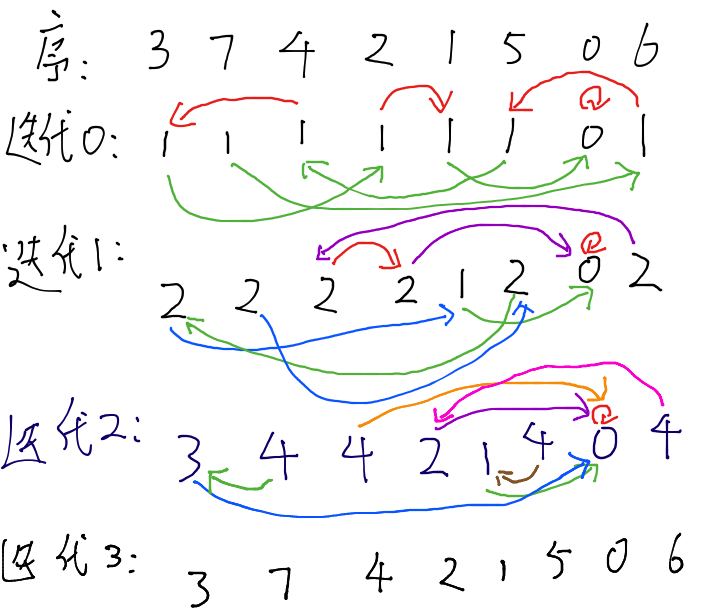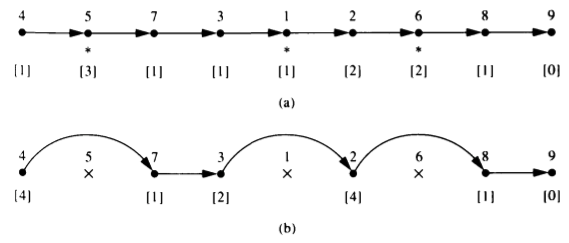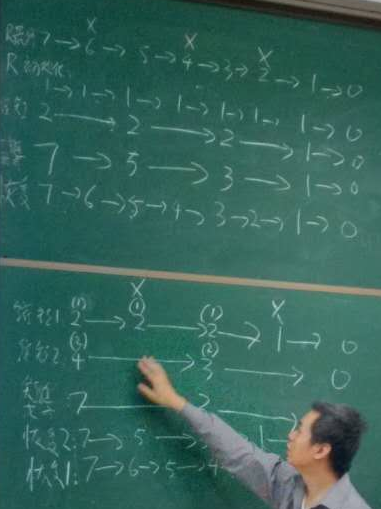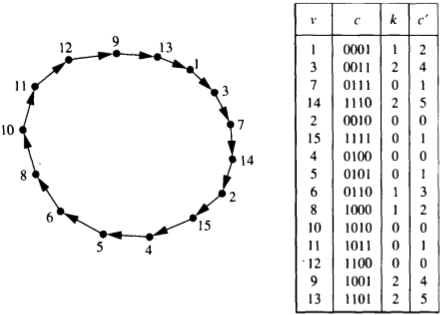(并行与分布式计算二)
列表排序
The list-ranking problem is to determine the distance of each node i from the end of the list
指针跳转法(pointer jumping technique)
思想:
- 链表中的指针跳转可以由一次跳转一步改为一次跳转多步
- 如果能在O(1)时间内一次跳转k步,那么一次跳转2k步只需要双倍时间
- 如果为每个节点,把一次跳转2k步的跳转结果记录下来,那么以后一次跳转2k步也只需要O(1)时间
- 反复利用跳转步数翻倍和跳转结果记录的技巧,可以在O(log N)的时间内把跳转步数扩大为N
T = O(logn); W = O(nlogn)
并不比串行算法(linear, O(n))更优
Algorithm 3.1
优化思路:
- 用快速并行算法把链表长度缩短为n/log n
- 要求:缩短和恢复都可以用很小的T,并且W=O(n)
- 方法:通过删除链表中的独立顶点集来缩短链表
- 在缩短的链表上用指针跳转法来求序,只需W=O(n)
- 最后用快速并行算法来恢复链表的长度
也即:
- 把列表分成约n/logn块{ $B_{i}$ }, 每块包含O(logn)个节点
- 在每块内对每个节点用最优串行算法求序(preliminary rank)
- 用O(logn)的平行算法把所有排好序的块组合
List-Ranking Strategy
- Shrink the linked list L until only O(n/logn) nodes remain.
- Apply the pointer jumping technique(Algorithm 3.1) on the short list of the remaining nodes.
- Restore the original list and rank all the nodes removed in step 1.
independent sets
- A set I of nodes is independent if, whenever i belongs to I, S(i) not belongs to I.
缩减的列表结点必须构成一个独立集,即不相邻
Algorithm 3.2
删除独立顶点集并合并其权重到剩余顶点的并行复杂度: T=O(1) W=O(n)
Determination of an Independent Set
独立集合充分大:存在常数c,c属于(0, 1),使集合包含顶点数不少于c×n
- 保证快速地迭代缩短链表
- 把长度为n的链表缩短为n/logn只需不超过log_1-c(logn)的T
最理想但没有快速算法:用序的奇偶性确定独立顶点集合,c=1/2
(存在快速算法)对链表使用三色着色算法,把局部最小色数(或最大)的节点作为独立集元素
- 从一个局部极小到下一个局部极小着色点,中间经过的点数最多为3,因此C=1/4
- 3-color 算法收敛很快,每次调用算法,
着色的色数都变小为原色数的对数比例,这里的对数以2为基底 - 要把色数变小为3,T几乎是O(1)
Algorithm 3.3
缩短链表和恢复链表:T = O(log logn), W = O(n)
- 把长度为n的链表缩短为n/logn,只需不超过log_1-c(logn)的T
- 第一次迭代W = O(n), 第二次迭代W = O((1 - c)*c), …
- W = O(n + (1 - c)n + (1 - c)^2 *n + …) = O(n/c) = O(n)
- 恢复和缩短是对称的,T和W都相同
指针跳转是在长度为n/logn的已缩短链表上zuo做的,T = O(logn), W = O(n)
算法的并行复杂度: T = O(loglogn); W = (n)
- *一个优化的时间复杂度为O(logn)的列表求序算法……
欧拉回路(the Euler-Tour Technique)
树的欧拉回路是指:
将一棵树的每一条边换成两条指向相反的有向边,成为一个欧拉图,就存在欧拉回路;
可以定义一个论域为所有有向边的函数s(successor function),描述这棵树的欧拉回路
Lemma 3.6: Given a tree T = (V, E) and an ordering of the set of vertices adjacent to each vertex v belongs to V, the function s defined previously specifies an Euler circuit in the directed graph T’ = (V, E’), where E’ is obtained by replacement of each e belongs to E by two arcs of opposite directions.
we call the Euler circuit of T’ the Euler tour of T
每棵树都有欧拉回路
- 如果欧拉回路从树的根节点出发,则它实际上是树的节点深度优先遍历路径
给出一个由邻接表及附加的指针信息描述的树,求得一条欧拉回路的T = O(1), W = O(n), |V| = n
(指针信息: data field + pointer * 2(描述下一个邻接点 + 描述该点在邻接表中指向此顶点的item))
树求根(rooting a tree): 树根结点为r,对于每个非根结点v,寻找其父父结点p(v)
一对顶点之间的两条弧,先出后进的顶点是父节点,先进后出的是子节点
弧的顺序的确定:
-把欧拉回路从其中一点处断开(例如去除回路路径列表中的最前与最后的弧的相邻关系)
- 用链表求序来对这些弧定序
树的一个欧拉回路为L[r] = < u_0, u_1, … , u_d-1 >
设s(< u_d-1, r >) = 0,将欧拉回路从r处截断,得到一条始于r,遍历所有顶点一次,终于r的欧拉路径
Algorithm 3.5
并行复杂度与链表求序相同:
- T=O(log n log log n) ???
- W=O(n)
- 这里n是顶点数(树的边数是顶点数减一)
1、Postorder Numbering 后序遍历的序数
往下走的弧的权重为0,往上走的弧的权重为1,然后用链表中求前缀和的方法来算出后序遍历编号
Algorithm 3.6
2、Computing the Vertex level 结点层数
可用类似Algorithm 3.6的算法,1和3做改动: w(
3、Computing the preorder Number
w(< p(v), v >) = 1; w(< v, p(v) >) = 0;
preorder(v) = < p(v), v >前缀和 + 1; preorder(r) = 1
4、Computing the Number of Descendants
w(< p(v), v >) = 1; w(< v, p(v) >) = 0;
desc(v) = < v, p(v) >前缀和 - < p(v), v >前缀和; desc(r) = n - 1
以上四个并行算法:
T = O(logn); W = O(n)(由平衡树方法求前缀和的平行算法所决定)
- *Tree Contraction(树收缩) ……
- *Lowest Common Ancestors ……



